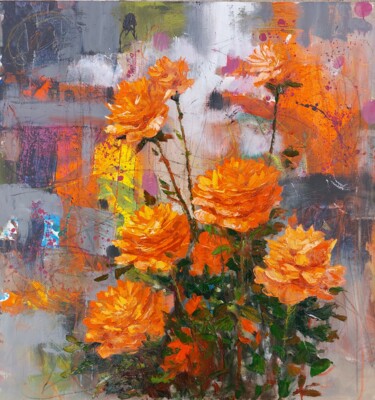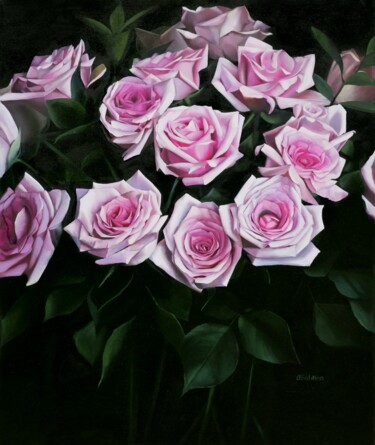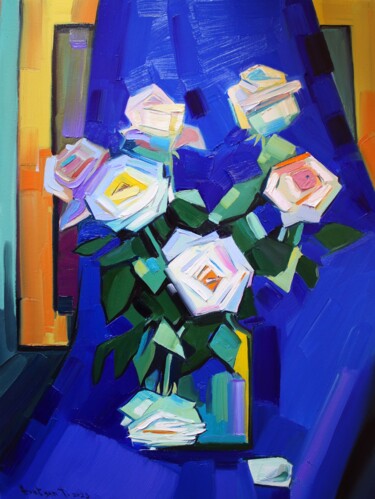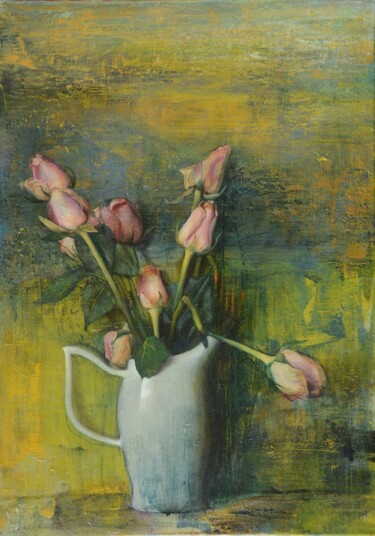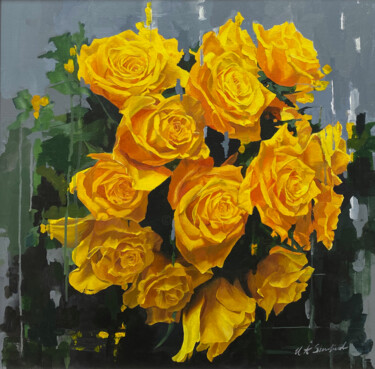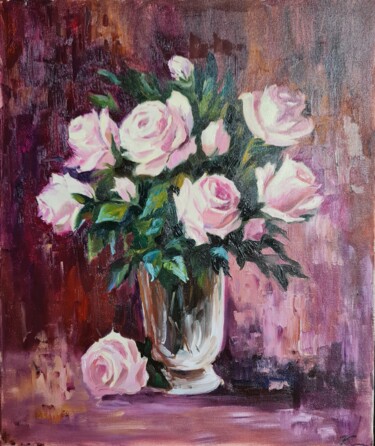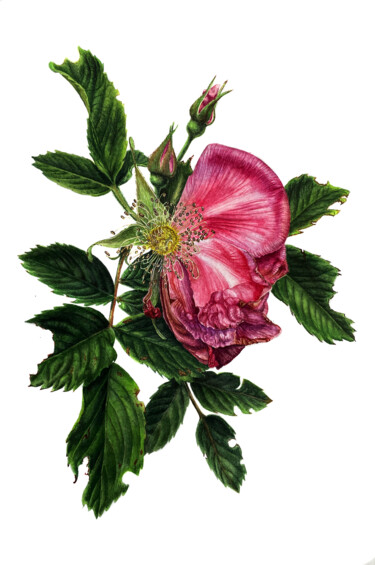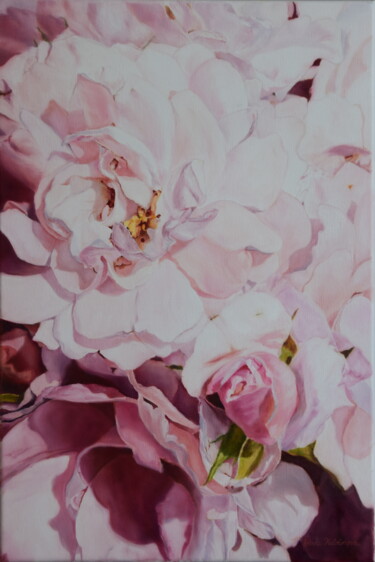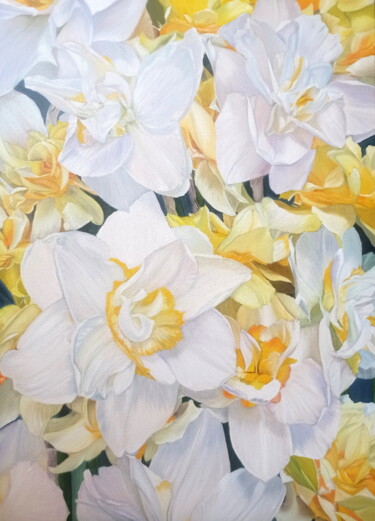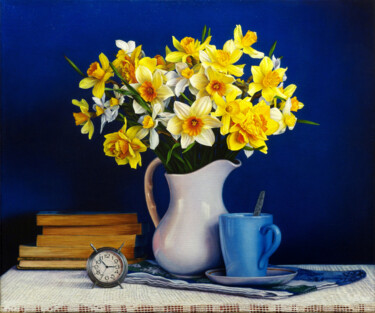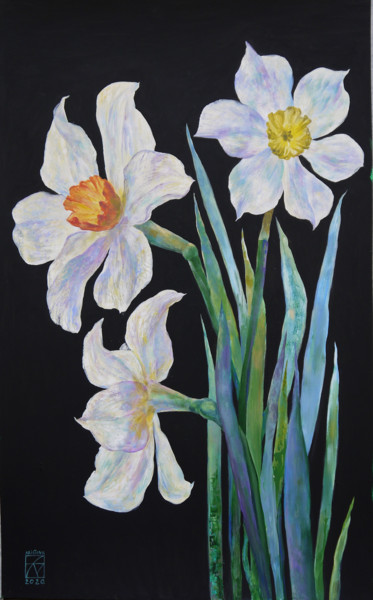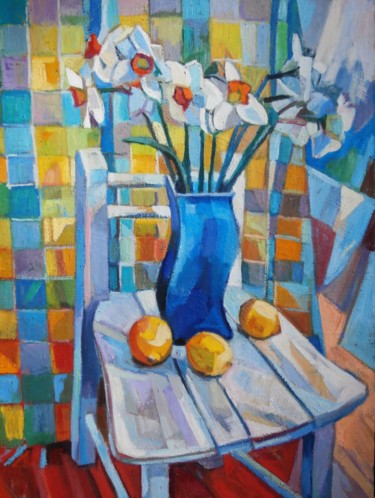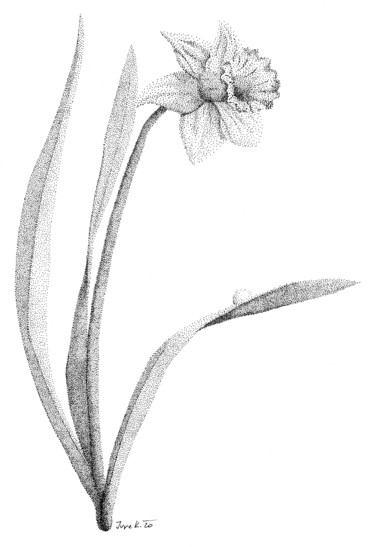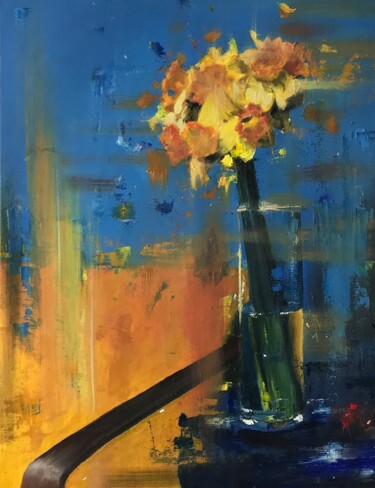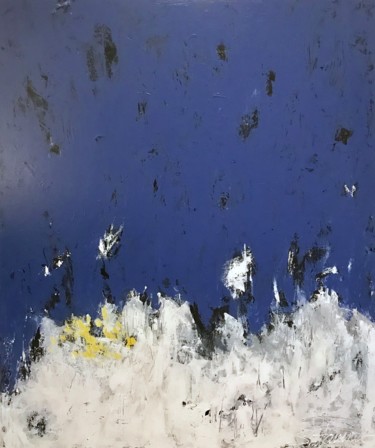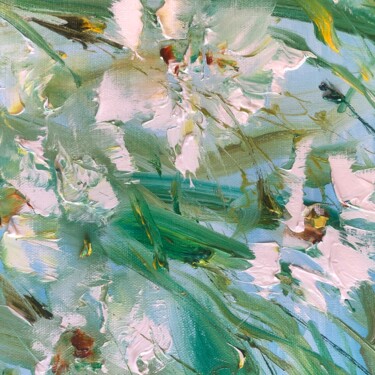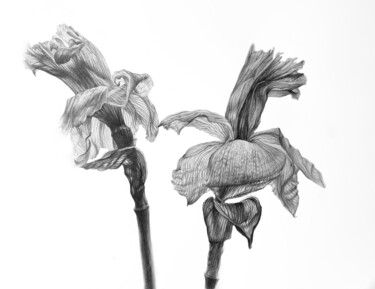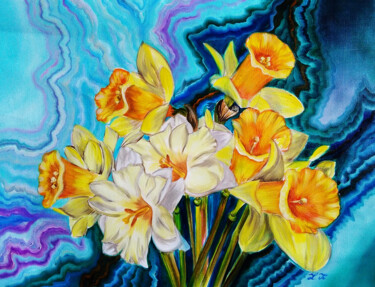 ROSES (2021) Pittura da Valery Marche.
ROSES (2021) Pittura da Valery Marche.
My ranking of still lifes with flowers brings together all those, which, in my opinion, have been the most iconic and "commercial" works of the aforementioned genre, which I have arranged within a narrative in descending order, aimed at culminating in the symbol par excellence of the subject, that is, in that masterpiece that no one, or almost no one, can be spared from misrecognizing, which I have taken the liberty of electing as the iconic representative poster of "flower-themed" paintings par excellence. Before moving on to the top 10, however, it is good to enter, at least for a moment, into the historical context to which still lifes with flowers belong, natural subjects born, initially as a minor artistic manifestation compared to historical, religious or mythological ones, from the hand of the Flemish Hans Memling, who, in about 1490, laid the foundations for the continuation of a subject that has now become inescapable, thanks also to the fact that, over the centuries, it has achieved an intensity and aesthetic originality far superior to a simple botanical reproduction. In addition, after the success encountered by the genre within the Art Nouveau style, we owe to the advent of the twentieth century the intuition to go beyond reproducing flowers only as they are, to involve them within assemblages, installations, photographs, etc. We interrupt this long, ancient and future history to turn to the works that, between the late nineteenth century and the 2000s, have for me represented the pinnacle of the genre, in that they are not only technically and stylistically unprecedented, but also true "mainstream products" highly contemplated by the masses.
Murakami with a specimen from his Flower Ball series. @soulr.co
10. Takashi Murakami, Flowerball Pink, 2007
Said succinctly and without making any reference to the intentions, training and influences at the origin of Murakami's work, Flowerball Pink (2007) is a circular print filled with an intense and "crowded" splash of bright flowers, which, each endowed with a smiley face, create a feeling of illusory three-dimensionality, intended to animate the entire Flower Ball series, of which the aforementioned print is precisely a part. Adding in this succinct description of the missing details, Murakami's popular flowers, as much a staple of the artist's career as Campbell's Soup Cans can be for Warhol, arise from an original reinterpretation of traditional Japanese painting, in which flowers were oft depicted. Adding to this ancient iconography is the careful observation of the world of manga, anime and Japanese subculture, generators of commercial objects, which are transformed into art by Takashi through the blurring of the boundaries between consumerism and art, an attitude that once again echoes the intentions of 1950s Pop art. Despite such affinities, Murakami's drawings go beyond the mere juxtaposition of high and low culture, as hidden tears can be glimpsed behind the aforementioned bright smiles, capable of shaping that mature courage capable of concealing suffering behind a dignified manifestation of serenity. In fact, the latter observation is linked to a painful statement made by the artist to the New York Times, in which he confessed, that his Smiling Flowers are nothing but a mute manifestation of the repressed emotions, as well as the traumas, collectively experienced by the Japanese in the most dramatic moment of their history: the Hiroshima-Nagasaki bombings of 1945.
Flower Sculpture by Yayoi Kusama. @kusama_archive
9. Yayoi Kusama, Ready to Blossom in the Morning, 1989
Again, she does not contradict herself! Yayoi Kusama, a contemporary Japanese artist extremely well known for her compulsive use of dense patterns of polka dots, decorations due to her inspiration, inexorably drawn from the dramatic and rounded hallucinations from which the artist has suffered since childhood, does not take us by surprise when she chooses to repurpose her most cherished motif also to give life to a repetitive red background, aimed at materializing in the dots surrounding the two flowers, aimed at silhouetted in the foreground. If the obsession just revealed, manifested in this case through the depiction of the world of flowers amazed you, then you are not familiar with the work of the Japanese artist, who on other occasions has approached, again compulsively, the floral world, just as when, for example, during the National Gallery of Victoria's Triennial (Melbourne, 2018), she allowed visitors to freely place multitudes of gerberas on all available surfaces in a room. That work, titled Flower Obsession, finds explanation, once again, through the repetition of the aforementioned visions, although, this particular case, it is the artist herself who reveals the origin of the installation: "It all started with a hallucination. One day as a child, after observing a pattern of red flowers on the tablecloth, I looked up and the ceiling, windows and columns seemed to be plastered with the same red floral pattern. I saw the whole room, my whole body and universe covered with red flowers, and in that instant my soul was erased ... That was not an illusion, but reality itself."
Andy Warhol, Flowers, 1964.
8. Andy Warhol, Flowers, 1964
Prior to 1964, somewhat unbelievably, Warhol's repertoire lacked, almost unforgivably, the approach to a primarily naturalistic subject such as, say, flowers! How had the Pittsburgh artist been able to forget such a recurring genre in art history, perhaps to be turned into a repetitive consumer object to be compulsively offered to the masses? In fact, Andy never presented an independent interest in the above subject, so much so that his analysis was prompted by the intervention of Henry Geldzahler, curator of contemporary art, who urged Warhol, during the '64 World's Fair in New York, to enrich his production with the natural element par excellence. Eventually, however, Andy became intimate with such a subject, in particular with Hibiscus, which, made in a style aimed at combining impressionist and abstract techniques, pursued the intention of giving voice to the artist's innermost soul and perhaps, also the one least exposed and controversial, as it is oftentimes concealed by the appearances of the consumerist narrative. So far so good, so much so that Warhol interpreted the subject matter multiple times, but one day the bitter truth came to light: The "Flowers" silkscreens clearly take up the image of Hibiscus flowers from the photographs of Patricia Caulfield, an artist who, not questioned by Warhol, went straight to legal action!
7. Roy Lichtenstein, Black Flowers, 1961
We have come to the seventh position, occupied by one of the main artists of Pop art, along with the one just discussed above: I am talking about Roy Lichtenstein, known for his works inspired by newspaper and comic book prints, especially those, which, made by means of the Ben-Day dot, illustrated the life of the time, passing into history, above all, through masterpieces such as Whaam! (1963), as well as those depicting beautiful blond ladies, who, rather condescendingly, almost went so far as to cry and smile on command. In this production, in which we can also include works featuring Donald Duck and Mickey Mouse as subjects, as well as remakes of well-known masterpieces, who would have thought that we could also find some floral still lifes? At this point I introduce Black Flowers, a work that, despite being dated 1961, that is, to be placed at the beginning of the artist's career, already brings back some of Lichtenstein's more mature stylistic features, which, indelibly marked by the world of comic strips, come, in this case, to subvert the chromatic beauty of flowers, to capture them in an uncommon black and white, aimed at rising above a vase in the shape of a fluted column, a detail that makes possible the union between the classical and the magazine worlds.
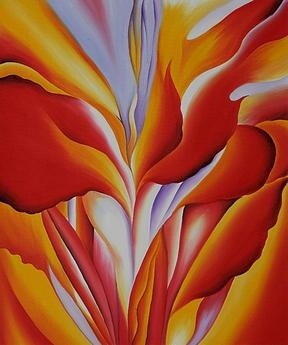 Georgia O'Keeffe, Red Canna, 1924. Oil, 73.7 x 45.7 cm.
Georgia O'Keeffe, Red Canna, 1924. Oil, 73.7 x 45.7 cm.
6. Georgia O'Keeffe, Red Canna, 1924
It was just impossible not to include in this top 10 the work of O'Keeffe, an American artist best known for her paintings of flowers, which done in close-up or on a large scale, represented some of her best-known masterpieces, dating from the mid-1920s to the 1950s. Within this vast floral production, I wanted to choose as a representative work Red Canna (1924), a canvas depicting a reed lily "enlarged," and thus seen up close, whose perspective pursues the intent of acquainting us with, and appreciating, the beauty, richness and delicacy of an open flower, interpretable, in a parallel, erotic and sensual way with the close-up view of the most hidden part of femininity, a "dimension" often recognized by observers within much of O'Keeffe's floral repertoire. In fact, the mischief lies precisely in the eye of the beholder, as the painter impetuously declared that her work had been literally misunderstood, becoming a symbol of a masculinist interpretation, formulated by a predominantly male art critic, who had perpetuated a sexual conception of her work that was actually very different from her original intentions.
Henri Matisse, Spray roses in front of the window, 1925. Oil on canvas, 80×65 cm. Private collection. @paintings_i_love.
5. Henri Matisse, Flowers, 1907
Matisse, a leading exponent of the Fauves, distinguished himself, as did the other spokesmen of the latter artistic current, by the popularization of simplified forms, the abolition of perspective and chiaroscuro, and the use of bright, unnatural and pure colors. The floral still life Flowers, dated 1907, with its less "aggressive" and slightly more "naturalistic" colors than the above-mentioned, counts, more than the astonishment conveyed by vibrant hues, of the movement of the highly expressive brushstroke, aimed at constructing flat and graphic forms, which approach the more "classical" theme of still life. If this is the description that applies to Flowers (1907), it is good to highlight how, within the artist's long career, he repeatedly returned to the theme of flowers, interpreting them within more or less developed contexts, including interior scenes and landscapes, such as, for example, Purple Robe and Anemones (1937) and Interior with Dog (1934).
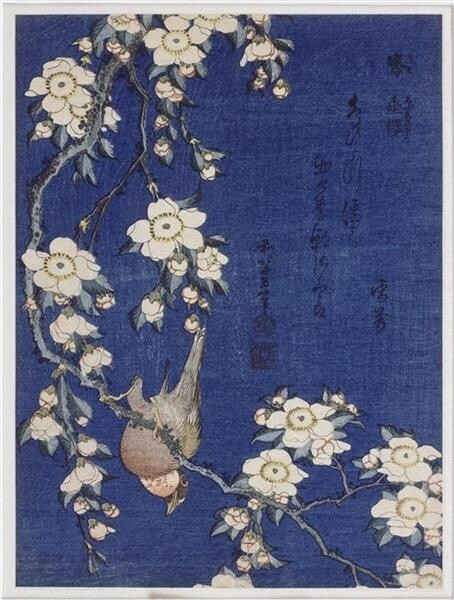
Katsushika Hokusai, Bullfinch on Weeping Cherry, 1840.
4. Katsushika Hokusai, Bullfinch on Weeping Cherry, 1840
"A single bird bathes / its feathers and flies away: / morning cherry tree": this is the translation of the inscription found on the print Bullfinch on Weeping Cherry (1840), which shows the seventeen syllables attributable to Bunrai'an Setsuman, a haiku poet of Setsumon, a school with which Hokusai was associated and also referenced for the text shown on the painting Pines and Mt Fuji. Speaking of the cherry blossom tree, mentioned by the same quotation, this is the undisputed protagonist of the work, which, amidst flowers and buds, is presented together with a bullfinch, a volatile that in Japan is the well-known figurehead of a ceremony held every New Year's Eve at Tenjin shrines. On this occasion one must go to the sacred place armed with the previous year's bullfinch in order to replace it with the one of the new course, which, blessed, will protect its owner from the misfortunes of the following year. The benevolent animal, on the other hand, realistically realized in Hokusai's print, is definitely a male specimen, just as can be seen from the pink marking, which extends from the cheek to the bird's throat. Finally, the flowers, the Prussian blue, the bird, and the inscriptions form a harmonious whole, capable of telling us about the highest artistic tradition, as well as customs and culture, of Japan.

Gustav Klimt, The Sunflower, 1906 - 1907. Oil on canvas, 110 x 110 cm. Private collection.
3. Gustav Klimt, Sunflower, 1906
Forget The Kiss (1908), The Judith (1901) and The Three Ages of Woman (1905), works that have led us to think that Klimt was perhaps more skilled, and certainly more interested, in portraying the human figure, rather than nature, or still life. While the first hypothesis is surely incorrect, given the eclecticism of the artist, the second seems to be quite plausible, as the Sunflower of 1906 turns out to be a subject unusually devoid of the most typical anthropomorphic element. In any case, Klimt's aforementioned flowers seem to be very similar to human beings, as they stand erect in a garden, where they live, still turning out to be far from being bound in the space of a vase along with fruit and other dying floral specimens. For this reason, if we really want to be punctual, the masterpiece, rather than falling totally into the still life genre, would seem to be somewhat akin to the landscape genre, within which the sunflowers take on the movements of the protagonists of the above-mentioned masterpieces, especially, echoing the grasp of the lovers in The Kiss with their leaves joined in a similar embrace.
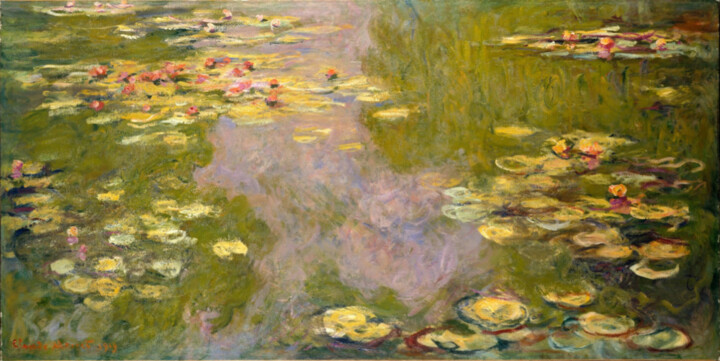 Claude Monet, Ninfee, 1919. New York: Metropolitan Museum of Art.
Claude Monet, Ninfee, 1919. New York: Metropolitan Museum of Art.
2. Claude Monet, Water lily pond, green harmony, 1899
Also halfway between "still life" and landscape is Monet's long series of water lilies, which, while placed outdoors and still alive, become models in the same way as the more "homely" vases, fruit and flower arrangements. This cycle of more than 250 paintings, made between 1890 and 1926, actually recounts the master's detachment from some of the peculiarities of the movement he himself represented: Impressionism. In fact, if one of the peculiarities of the latter was to paint "en plein air," in order to fix in a single image, made quite on the spur of the moment, the impression of a precise moment, the master fell short of this way of working for two reasons: the size of his last canvases and the winter season. Regarding the former, the large media were strictly kept in his studio, a place where he was able to fragment his impressions captured from life and then recompose them into a sequence of coherent moments. As for the winter season, on the other hand, the cold weather meant that the artist, with the help of mobile easels, could begin his work outside and then finish it in his studio, where he was able to achieve a skillful overview.
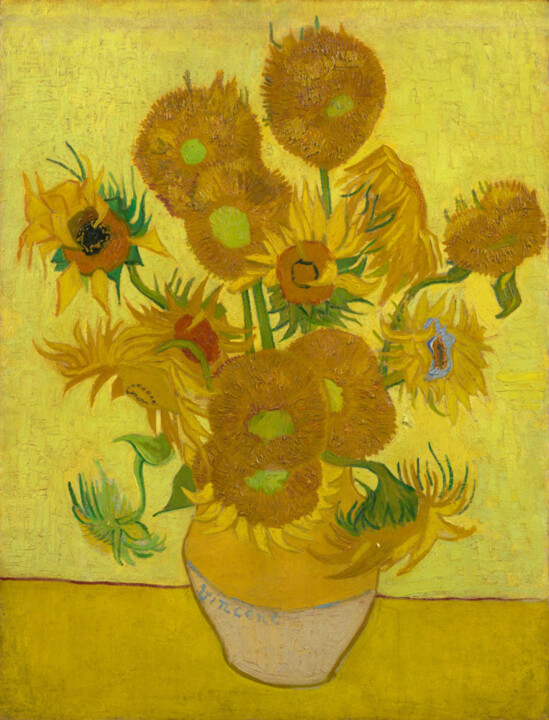 Vincent van Gogh, Sunflower, 1889. Oil on canvas, 95 x 73 cm. Amsterdam: Van Gogh Museum.
Vincent van Gogh, Sunflower, 1889. Oil on canvas, 95 x 73 cm. Amsterdam: Van Gogh Museum.
1. Vincent Van Gogh, Sunflowers, 1889
And the winner is: Vincent! I have to tell the truth, I have always had a soft spot for troubled spirits, but in this case his sunflowers truly represent an inescapable still-life masterpiece for the history of art, as they achieve the perfect synthesis of the artist's outer reality and inner world. In fact, the painting, depicting a bunch of sunflowers gathered in a pot-bellied vase and displayed on a plane, precisely against a light-colored wall, is a well-known example of the figurative experimentation of a master, who lived painting as a daily existential therapy, that is, both an artistic pursuit and a filter with which to face reality. In addition, the sunflower series was made with the intention of expressing gratitude to his friend and colleague Paul Gauguin, so much so that it does conceived to decorate the room Vincent set up for him in Arles, in the Yellow House, where the Frenchman had joined him. Even, the Dutch master loved this flower so much that he came to identify with it, to the point of calling it, "completely Vincent." Finally, it is also important to note that the sunflowers placed in the vases by Van Gogh are, at times, as revealed to his brother Theo, fourteen or fifteen, in order to refer to the numbers of Christ's apostles added to the figures of Theo and Paul Gauguin, to which the presence of Vincent himself could also be added.

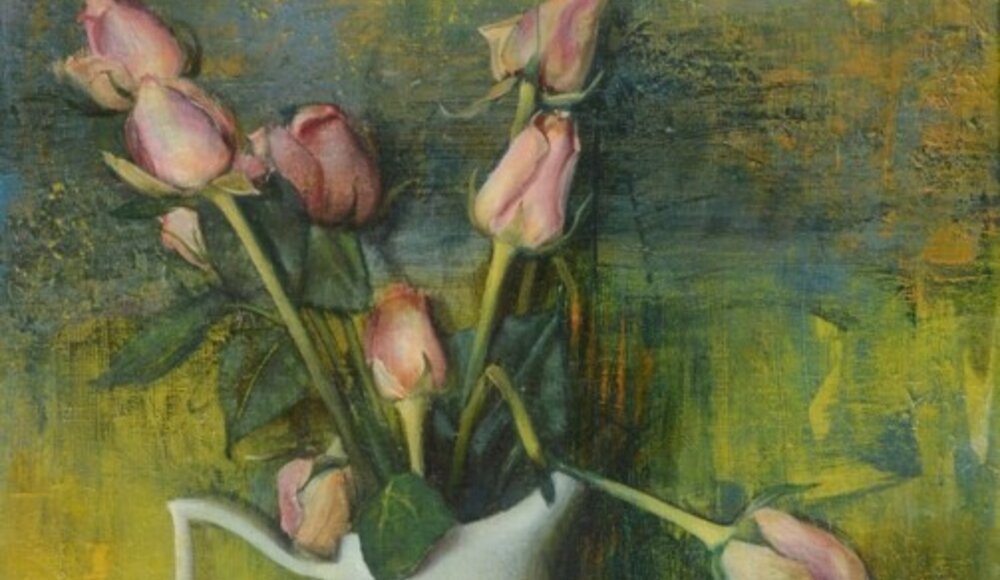
 Olimpia Gaia Martinelli
Olimpia Gaia Martinelli
